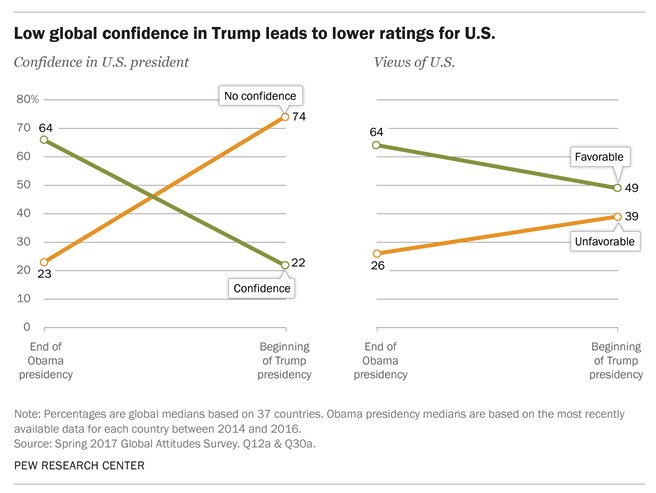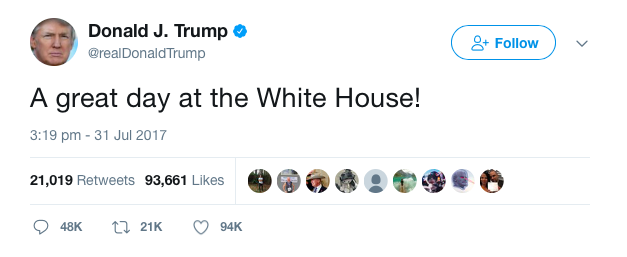Six months in, are the wheels coming off President Trump’s “fine-tuned machine” or will the latest reboot give the administration desperately-needed breathing space? And, crucially, what does the ongoing chaos say to the rest of the world?
I’m honestly not sure how many times you can write a headline that says a particular week was Donald Trump’s “worst yet.”
But if you doubted for a second that last week actually was, Maureen Dowd’s summation in Sunday’s New York Times was illustrated with a detail from Hieronymous Bosch’s 16th-century apocalyptic hellscape ‘The Last Judgment’.
This week had barely kicked off when one of the soap opera’s most colourful new characters, Anthony Scaramucci, was written out before viewers had time to learn the details of his disintegrating marriage. Written out, indeed, even before he had officially started as White House Communications Director.
Scaramucci’s by-now infamous profanity-ridden interview with Ryan Lizza at the New Yorker which prompted the departure of Chief of Staff Reince Priebus was on Monday deemed “inappropriate” and offered as a reason for giving Priebus’ incoming successor, Homeland Security Secretary Gen. John Kelly, a “clean slate” to bring discipline and order to the West Wing.
And almost before he was here, the Mooch was gone.
As the Washington Post points out, four men have now done five stints as Trump’s head of comms, lasting a Clough-at-Leeds-style average of 44 days.
Yet with language more about intercourse than discourse it briefly seemed that, in Scaramucci, Trumpism had finally found its true voice. After all, one rationale for a lot of Trump supporters had been that he’s “just like them” and speaks the way they do, with little reserve or restraint.
The New Yorker’s David Remnick wrote that the new communications chief was “channeling Trump”, while literally hours before his ouster, an article at The Federalist argued that Scaramucci “is the man Trump and America need”.
At the end of the day, it’s better that we know what the president genuinely feels about such issues, not what his comms team thinks is the best message. This is because the president will not follow his comms team’s advice and is going to cut his own path. Let’s hear Trump out, let’s have his ideas and policies displayed in all their glory and not let career handlers try to massage the message. The communications director is the mouth of the president. In his colorful way, Scaramucci is not just the Mooch, he’s the mouth, and it sounds very much like Trump’s.
Yet leaving aside the fact that the Mooch’s penis-heavy public rant would likely have resulted in instant dismissal in any other work environment, the question remained how well the administration was going to be practically served by a Director of Communications who didn’t seem to understand the concept of on-and off-the record.
Matt Taibbi at Rolling Stone could see the slow-motion trainwreck approaching, predicting the Scaramucci era would be “freakish, embarrassing and short.”
Taibbi – undoubtedly one of the most astute and indispensible observers of the current craziness that passes for government – also said that Scaramucci’s appointment had “reignited the comic potential of the Trump presidency” and no doubt there will be comedians who will have just perfected their Moochian accent before the character’s 15 minutes was up.
Ego and infighting
One of the first rules of effective political messaging is to get all your people on the same page, and ensure there’s consistency in everything that gets said on your behalf as well as who controls access to the main decision-maker. One of the problems with the Trump White House had been that Priebus as Chief of Staff was just one of three competing centres of power, along with chief strategist Steve Bannon and the Jared/Ivanka axis.
The rival factions were even described as resembling the “bloods and the crips”. 
But now, according to press secretary Sarah Huckabee Sanders, “all staff will report to him,” referring to Kelly, whose immediate challenge is to stabilize what had become an increasingly chaotic work environment.
According to Time: “At the same time, Kelly’s own boss may chafe under a more disciplined regime. As President, Trump’s managerial style has been to pit aides against one another. Some outside allies worry that under Kelly, the attacking style that helped lift Trump into office will disappear. So far there’s no sign of that: in the 72 hours since Kelly’s selection was announced, the President has continued to lash out on Twitter.”
But Trump’s scattergun tweets indicate that, short of physically taking his phone from him, controlling any message out of the White House is always going to be a challenge. While there are problems aplenty with the messaging domestically, particularly in the wake of last week’s healthcare debacle, which rendered meaningless the GOP’s “repeal and replace” rhetoric, perhaps more concerning is how the rest of the world continues to see the administration amid a series of sensitive global potential flashpoints.
Presidential tweets about China and North Korea in the wake of another missile test, contrasted with the silence over Russia’s expulsion of US diplomats, as well as the agonizing nine minutes of uncertainty between messages on his proposed transgender policy led Bloomberg to write: “For humanity’s sake, delete your account”.
Along with low morale at the State Department, meanwhile, a new Pew poll shows that a steadily declining confidence in the President is diminishing the favorability of the US overseas.

A Better Deal?
Regardless of who replaces Scaramucci in attempting to control the White House’s messaging, the Democrats have been gearing up to present a counter–narrative. But there’s only so much news oxygen to go round, and their “Better Deal” campaign, aimed at recapturing Trump’s populist image, hasn’t exactly caught fire.
Electorally, the signs don’t seem to be good. A new poll shows the task that faces them ahead of next year’s midterm elections.
The poll surveyed working-class white voters in pivotal districts that Democrats are targeting in the midterms. Despite the Trump turmoil in Washington, Republicans held a 10-point lead on the generic ballot (43-33 percent) among these blue-collar voters. Democrats hold a whopping 61 percent disapproval rating among these voters, with only 32 percent approving. Even Trump’s job-approval rating is a respectable 52 percent with the demographic in these swing districts.
Democrats maintain that with robust economic messaging, they can move those numbers in their favor. But the results show how difficult that task will be. By a stunning 35-point margin, blue-collar white voters believe that Republicans will be better at improving the economy and creating jobs than Democrats.
The President, meanwhile, is no stranger to “reboots” having gone through a couple during the campaign, even if the challenge of this one might be more serious. One signal we saw with Priebus’ exit is the administration’s further untethering from the establishment GOP
And even with some considered misgivings about enabling the rise of Trump, like those from Arizona GOP Senator Jeff Flake in his new book, it’s important to remember two things here: First, that in the primaries, Trump’s appeal was ranged as much against the elites of the Republican party as against the Democrats. Second, for many of the people who voted for him early and have stuck with him, the fact that nothing is being accomplished legislatively is not necessarily a problem, and his support among that group is generally holding steady.
George Will, writing in the Washington Post at the weekend, says that Trump is “something the nation did not know it needed”. If that’s really the case, though, it has to be asked whether there’s anything people won’t tolerate?
And, ultimately, will it really matter who’s trying to control the message while the President is beyond control, or at least, seemingly inhabits a universe where everything is just fine, thanks…

Also published on Medium.
